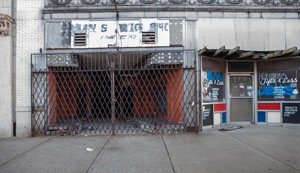Larry Chatman: Where "we" Live
© © Larry Chatman, 2016
Where "we" Live
I was born to Black America in 1951. The people in my neighborhood ranged from the poor to the rich. They weren’t really rich by white people’s standards but they were faring as prosperously as it seemed blacks could at that point in time. Despite the structural racism and overt attempts to subjugate blacks as a people through government and social institutions, by coming together, blacks were able to build and maintain thriving communities and provide for themselves and their neighbors, a chance at the American Dream. Black professionals and ordinary working people built a self sufficient community; an island in the ocean of a large white urban city. In my neighborhood blacks provided nearly all the services and products that the community needed. From the pharmacy, supermarket, gas station, and restaurants, to the shoe repair, barbershops and salons, they were black owned and operated. As blacks, we didn’t have access to many services provided by whites. Back then segregation in all forms was paramount. Whites generally would not work for blacks, so we blacks provided for ourselves. As difficult and degrading as it was living in a segregated community in many ways it was also a rich and nourishing environment.

In our communities across the country, blacks in large urban centers had a wealth of positive and negative role models. There were thugs, pimps, drunks, and dope dealers in our community. However, the negative influences were vastly outnumbered by the positive influences. There were shopkeepers, business owners, service providers, teachers, and average decent people that went to work everyday to provide for their families. A kid growing up in this environment saw many avenues to their future. They saw, by example, that they could be whatever they chose. It wouldn’t be easy, but men and women that looked just like they did and who lived where they did served as visible evidence that success was possible - more so by ethical and moral means than by nefarious means. That was how I grew up.
In 2011, I decided to go back to my old neighborhood. I wanted to see my old house and school, to go to my childhood and adolescent haunts. I knew it wouldn’t be the same as when I was a kid but I expected a semblance of what I remembered. What I found was tragic and deeply depressing. My house was gone. An empty lot was there in its place. The homes where my friends lived were either uninhabitable or also gone. What had been a middle class neighborhood had become what looked like Berlin in 1945. My grade school still stood, but was closed because there were not enough children in the area to support it. All the black owned businesses of my past were gone. There were no grocery stores, restaurants, or service providers that provided stability. The people that still lived here were too poor and too few to support a stable economy in the community. There were more storefront churches than businesses. It occurred to me, the misery of a neighborhood can be measured by the number of churches per square block.
 As I began to photograph my old neighborhood, I began to realize that the devastation I was witnessing was not reserved for my city alone. Every large city that practiced housing segregation in the past had suffered the same fate. I have photographed in many different cities in a variety of states to reveal the tragic desolation of historic black neighborhoods. The cities themselves do not need to be identified. When one views the photographs it is apparent where they were taken. This is, “Where we Live.”
As I began to photograph my old neighborhood, I began to realize that the devastation I was witnessing was not reserved for my city alone. Every large city that practiced housing segregation in the past had suffered the same fate. I have photographed in many different cities in a variety of states to reveal the tragic desolation of historic black neighborhoods. The cities themselves do not need to be identified. When one views the photographs it is apparent where they were taken. This is, “Where we Live.”
I’m a photographer. I try to make sense out of curiosities I see. As a photographer my interest is to comment on the relationships of society and culture. Making images that inform and challenge one’s beliefs or convictions has been my primary goal. During the period of legal housing segregation, black neighborhoods were vibrant, self reliant, and financially diverse. There were the ever-present and expected poor, but also professionals and semi-professionals. With the abolition of housing segregation, those with the financial means and personal drive unwittingly became the instrument of destruction for our neighborhoods. When these role models moved out, those that remained were mostly those who had no other options. They were the poor and the marginally or under employed. No community could remain viable after such an evisceration.
I seek to bring to light the bittersweet effect of housing de-segregation.
© Larry Chatman 2016